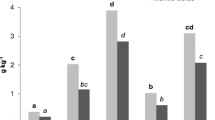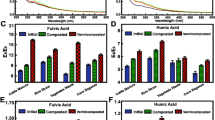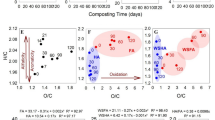Abstract
The effects of the composting process on the chemical and structural properties of humic acids have been studied in seven different organic waste mixtures from different origin. Only slight changes in elemental composition have been found in the humic acids after the composting process pointing to a more aromatic structure with higher proportions of oxygen and nitrogen. Functional groups were the most sensitive to the changes caused by the composting process showing a marked increase in the total acidity and phenolic, carboxyl and carbonyl groups. Gel permeation chromatography showed a slight increase in the average molecular weight of the humic acids. Infrared spectroscopy did not show important differences in humic acid structure but a clear decrease in the intensity of the bands in the region 3000–2850 cm-1 corresponding to the aliphatic fractions. As a general result, the composting process yields humic acids in which the elemental and functional composition are closer to that of the more humified soil humic acids.
Similar content being viewed by others
References
Ciavatta C, Govi M, Pasotti L & Sequi P (1993) Changes in organic matter during stabilization of compost from municipal solid wastes. Bioresource Technol. 43: 141-145.
Chefetz B, Hatcher PG, Hadar Y & Chen Y (1996) Chemical and Biological characterization of organic matter during composting of municipal solid waste. J. Environ. Qual. 25: 776-785.
Chefetz B, Adani F, Genevini P, Tambone F, Hadar Y & Chen Y (1998) Humic-acid transformation during composting of municipal solid waste. J. Environ. Qual. 27: 794-800.
Deiana S, Gessa C, Manunza B, Rausa R & Seeber R (1990) Analytical and spectroscopic characterization of humic acids extracted from sewage sludge manure and worm compost. Soil Sci. 150(1): 419-424.
Finstein MS, Miller FC, MacGregor ST & Psarianos KM(1985) The Rutgers strategy for composting: process, design and control. EPA project summary (EPA/600/S2-85/059). US Environmental Protection Agency, Washington DC.
Francioso O, Sánchez-Cortés S, Tugnoli V, Ciavatta C & Gessa C (1998) Characterization of peat fulvic acid fractions by means of FT-IR, SERS, and 1H, 13C NMR spectroscopy. Appl Spectrosc. 52(2): 270-277.
González-Vila FJ, Almendros G & Madrid F (1999) Molecular alterations of organic fractions from urban waste in the course of composting and their further transformation in amended soil. Sci. Total Environ. 236: 215-229.
He XT, Traina SJ & Logan TJ (1992) Chemical properties of municipal solid waste composts. J. Environ. Qual. 21: 318-329.
Hsu JH & Lo SL (1999) Chemical and spectroscopic analysis of organic matter transformations during composting of pig manure. Environ. Pollut. 104: 189-196.
Iglesias E & Pérez V (1989) Evaluation of city refuse compost maturity: a review. Biol. Wastes 27: 115-142.
Iglesias E & Pérez V (1992) Composting of domestic refuse and sewage sludge. II. Evaluation of carbon and some "humification" indexes. Resources, Conservation and Recycling 6: 243-257.
Inbar Y, Chen Y & Hadar Y (1990) Humic substances formed during the composting of organic matter. Soil Sci. Soc. Amer. J. 54: 1316-1323.
Kakezawa M, Nishida T & Takahara Y (1992) Structural Characteristics of humic acids extracted from woody composts by two-step composting process. Soil Sci. Plant Nutr. 38(1): 85-92.
Miikki V, Senesi N & Hanninen K (1997). Characterization of humic material formed by composting of domestic and industrial biowastes. Part 2: Spectroscopic evaluation of humic acid structures. Chemosphere 34(8): 1639-1651.
Niemeyer J, Chen Y & Bollag JM (1992) Characterization of humic acids, composts, and peat by diffuse reflectance Fouriertransform infrared spectroscopy. Soil Sci. Soc. Amer. J. 56: 135-140.
Perdue EM (1985) Acidic functional groups in humic substances. In: Aiken GR, McKnight DR, Wershaw RL & MacCarthy PC (Eds). Humic Substances in Soil, Sediment and Water (pp 493-526). Wiley-Interscience, New York.
Prudent P, Domeizel M, Massiani C & Thomas O (1995) Gel chromatography separation and U.V. spectroscopic characterization of humic-like substances in urban composts. Sci. Total Environ. 172: 229-235.
Sánchez-Monedero MA, Roig A, Cegarra J, Bernal MP and Paredes C (2002) Effects of HCl-HF purification treatment on chemical composition and structure of humic acids. Eur. J. Soil Sci. 53: 375-381.
Schnitzer M & Khan SU (1972) Characterization of humic substances by chemical methods. In: McLaren AD (Ed). Humic Substances in the Environment (pp 29-51). Marcel Dekker, New York.
Schnitzer M, Dinel H, Mathur SP, Schulten HR and Owen G (1993) Determination of compost biomaturity. III. Evaluation of a colorimetric test by 13C-NMR spectroscopy and pyrolysis-field ionization mass spectroscopy. Biol. Agri. Hort. 10: 109-123.
Senesi N (1989) Composted materials as organic fertilisers. Sci. Total Environ. 81/82: 521-542.
Stevenson FJ (1994) Humus Chemistry: Genesis, Composition, Reactions. John Wiley & Sons, New York.
Sugahara K & Inoko A (1981) Composition analysis of humus and characterization of humic acid obtained from city refuse compost. Soil Sci. Plant Nutr. 27(2): 213-224.
Swift RS & Posner AM (1971) Gel chromatography of humic acids. J. Soil Sci. 22: 237-249.
Tsutsuki K & Kuwatsuka S (1984) Molecular size distribution of humic acids as affected by the ionic strength and degree of humification. Soil Sci. Plant Nutr. 30: 151-152.
Unsal T & Sozudogru Ok S (2001) Description of characteristics of humic substances from different waste materials. Bioresource Technol. 78: 239-242.
Veeken A, Nierop K, de Wilde V & Hamelers B (2000) Characterisation of NaOH-extracted humic acids during composting of a biowaste. Bioresource Technol. 72: 33-41.
Author information
Authors and Affiliations
Rights and permissions
About this article
Cite this article
Sánchez-Monedero, M.A., Cegarra, J., García, D. et al. Chemical and structural evolution of humic acids during organic waste composting. Biodegradation 13, 361–371 (2002). https://doi.org/10.1023/A:1022888231982
Issue Date:
DOI: https://doi.org/10.1023/A:1022888231982




